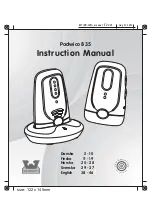
2 – Controls And Indicators
16
TASCAM FW-1884 Owner’s Manual
34. Master Fader
–
The Master Fader is a global
control, functioning in the same manner regardless of
which control mode is selected. Any movement of the
master fader is always communicated simultaneously to
the host computer, the MIDI control surface and the
monitor mixer. There is always one and only one mas-
ter fader for the entire system.
Additionally, the Master Fader can control the level of
the ANLG 1:2 outputs of the computer. A setting in
the FW-1884 control panel determines whether output
directed to ANLG 1:2 is passed through to the outputs
at unity gain, or whether the FW-1884 will apply Mas-
ter Fader gain to the ANLG 1:2 stream.
The Master Fader’s control of the DAW output may be
disabled within the FW-1884’s Control Panel if
desired. Refer to section 4.1, “Computer Control
Mode – (General Notes)”, for more information.
2.4
Rear Panel Control Descriptions
1. Headphone Outputs
– Headphone level out-
put on a balanced stereo ¼” connector.
2. Footswitch Inputs
–
Accommodates a stan-
dard momentary contact-closure footswitch on ¼”
connector. This input automatically detects the polar-
ity of a connected footswitch upon power-up.
3. Monitor Outputs 1-8
–
Eight ba4
dBU line-level ouputs on ¼” TRS jacks. The outputs
can be used for all modes of surround and multichan-
nel mixdown as supported by most major DAW appli-
cation software, up to eight outputs. For standard two-
channel monitoring, outputs 1 and 2 are used, with the
remaining outputs available for direct outs, effects
sends, etc. Refer to section 5.1, “Control Panel” for fur-
ther details.
4. Mic Inputs 1-8
–
Balanced XLR inputs at +4
dBu featuring high-quality mic preamps. These inputs
are wired in parallel with their associated Line Inputs.
Line Inputs 1-8
–
Balanced line level (+4 dBu) ¼”
TRS analog inputs. These inputs are wired in parallel
with their associated Mic Inputs.
Inserts 1-8
–
Individual channel inserts. These are
¼” TRS (tip-ring-sleeve) jacks which allow you to
insert an external processor into the signal chain. The
insert point is placed between the input (after the mic/
line trim) and the analog-to-digital converter. A stan-
dard insert cable with TRS plug is required. Check
with your music retailer.
Phantom Power switches
–
These two
switches supply
+
48V phantom power to the mic
inputs, for use with condenser microphones. Phantom
power is switchable in two groups of four channels.
NOTE
NOTE:
While most modern dynamic mics are unaffected by
phantom power, some ribbon mics may suffer damage
if phantom power is sent to them. When in doubt,
avoid plugging ribbon mics into an input where phan-
tom power is activated.
5. AC Power Input
– Connect the supplied IEC
power cable to this input. CAUTION – do not use
anything but an IEC-approved power cable.
Power Switch
– Push-on push-off recessed power
switch.
6. Word Clock Input
– Coaxial BNC connector
for input of external Word Clock signal from another
device. This input is 75 Ohm terminated.
Word Clock Output
– Coaxial BNC connector
for output of the FW-1884’s Word Clock signal to
another device.
7. ADAT Lightpipe and 2-channel Input
–
Fiber-optic input to accommodate eight-channel
ADAT and two-channel digital lightpipe formats.
ADAT Lightpipe and 2-channel Output
–
Fiber-optic output to accommodate eight-channel
ADAT and two-channel digital lightpipe formats.
8. D-In Coaxial Input
– S/PDIF coaxial digital
input on RCA connector.
D-In Coaxial Output
– S/PDIF coaxial digital
output on RCA connector.
















































